電子相関が強い系では、従来の理論の枠組みでは説明できない新規のメカニズムによる超伝導が出現します。当グループではそのような超伝導体の電子構造を決定し超伝導メカニズムを実験的、理論的に解明したいと考えています。
In strongly correlated electron systems, various fascinating phenomena
such as superconductivity due to novel mechanisms emerge at low temperatures
temperatures. We investigate the electronic structures of various superconductors
and their related materials, and try to clarify the mechanisms of the superconductivity
both experimentally and theoretically.
In order to clarify the mechanisms of novel superconductivity, we perform
systematic measurements of quantum oscillations, transport properties,
photo‐emission spectroscopy for various superconductors and their related
materials. We are also seeking fundamental concepts underlying novel superconductors
by utilizing analytical and computational methods.
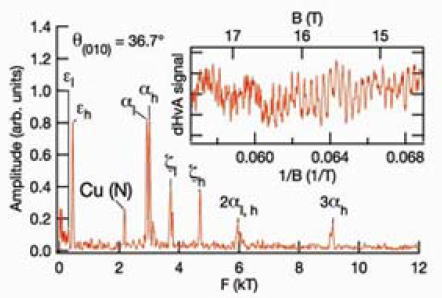
鉄系超伝導体のKFe2As2の量子振動(挿入図)のフーリエ変換スペクトル
Quantum oscillation (inset) and the Fouriertransform spectrum in a Fe‐based
Spontaneous symmetry breaking of Fermisuperconductor KFe2As2.

銅酸化物高温超伝導体におけるフェルミ面の自発的対称の破れ
Spontaneous symmetry breaking of Fermi surfaces in high Tc cuprates.
研究例 Research Topics
- 鉄系超伝導体および関連物質の研究 Fe based superconductors
- 有機超伝導体および関連物質の研究 Organic superconductors
- 高温超伝導銅酸化物および関連物質の研究 High Tc cuprates
- メゾスコピック超伝導に関する研究 Mesoscopic superconductors
- その他の強相関物質の研究 Other highly correlated materials
Kosterlitz-Thouless-Type Transition in a Charge Ordered State
of the Layered Organic Conductor α-(BEDT-TTF)2I3
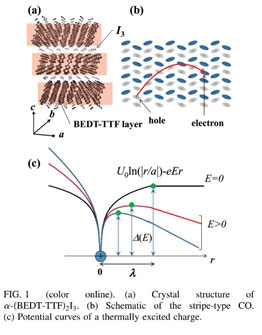
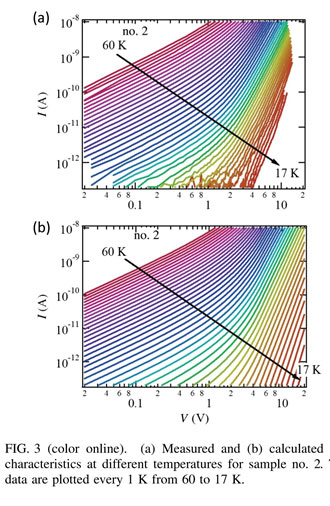
The current-voltage characteristics in the charge order state of the two-dimensional organic conductor α-(BEDT-TTF)2I3 exhibit power law behavior at low temperatures. The power law is understood in terms of the electric-field-dependent potential between electrons and holes, which are thermally excited from the charge order state.
The power law exponent steeply changes from 1 to 3 in the range from 30
to 45 K with decreasing temperature, thereby suggesting the occurrence
of a Kosterlitz-Thouless-type transition; many(few) unbound electron-hole
pairs are thermally excited above (below) the transition. The effects of
the finite size and interlayer coupling on the power law behavior are discussed.
S. Uji et al., Phys. Rev. Lett. 110 (2013) 196602
Fulde-Ferrell-Larkin-Ovchinnikov State in a Magnetic-Field-Induced Organic
Superconductor
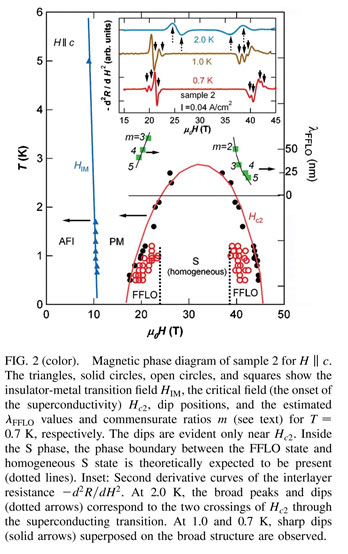
Under special conditions, a superconducting state where the order parameter oscillates in real space, the so-called FFLO state, is theoretically predicted to exist near the upper critical field, as first proposed by Fulde and Ferrell, and Larkin and Ovchinnikov. We have performed systematic measurements of the interlayer resistance in high magnetic fields to 45 T in the two-dimensional magnetic-field-induced organic superconductor λ-(BETS)2FeCl4. The resistance is found to show characteristic dip structures in the superconducting state. The results are consistent with pinning interactions between the vortices penetrating the insulating layers and the order parameter of the FFLO state. This gives strong evidence for an oscillating order parameter in real space.
S. Uji et al., Phys. Rev. Lett. 97 (2006) 157001,
Phys. Rev. B 85 (2012) 174530,
J. Phys. Soc. Jpn., 82 (2013) 034715
Axial anomaly in a quasi-two-dimensional metal PdCoO2
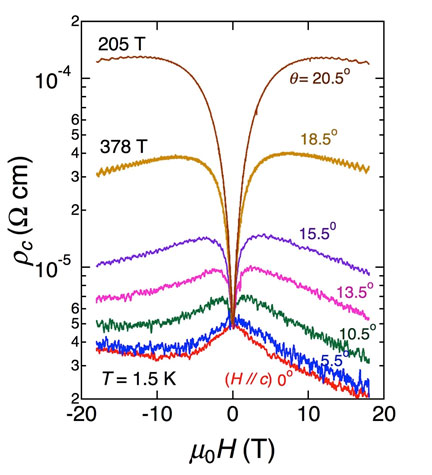
Axial anomaly leads to the violation of separate number conservation laws for left- and right-handed massless chiral (or Weyl-) fermions. For a certain class of gapless semiconductors, for which the low-energy band structure is described in terms of Weyl-fermions, the application of a magnetic field (H) parallel to the electrical current (I) is predicted to induce a large suppression of the electrical resistivity. We observe pronounced negative magnetoresistance in the extremely clean quasi-two-dimensional metal PdCoO2 when measuring interlayer resistivity under H // I // c. Here, this material is nonmagnetic, and has a half-filled single Fermi-surface. The negative magnetoresistance is robust under higher fields even when the field angle is tilted from the c axis to close to Yamaji angle. Our result provides strong support for a scenario originating from the axial anomaly of field-induced quasi-one-dimensional conduction channels.
N. Kikugawa et al., submitted. arXiv:1412.5168
Gapless Quantum Spin Liquid in an Organic Spin-1/2 Triangular-Lattice κ-H3(Cat-EDT-TTF)2
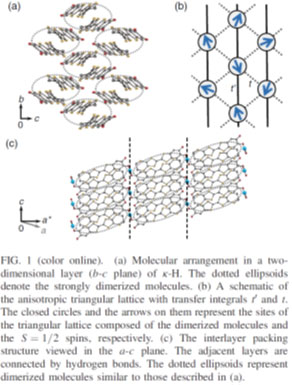
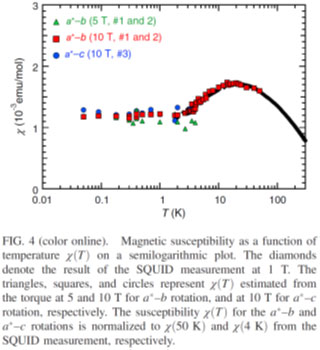
We report the results of SQUID and torque magnetometry of an organic spin-1/2
triangular-lattice
κ-H3(Cat-EDT-TTF)2. Despite antiferromagnetic exchange coupling at 80–100 K, we observed
no sign of antiferromagnetic order down to 50 mK owing to spin frustration
on the triangular lattice. In addition, we found nearly temperature-independent
susceptibility below 3 K associated with Pauli paramagnetism.
These observations suggest the development of gapless quantum spin liquid as the ground state. On the basis of a comparative discussion, we point out that the gapless quantum spin liquid states in organic systems share a possible mechanism, namely the formation of a band with a Fermi surface possibly attributed to spinons.
T. Isono et al., Phys. Rev. Lett. 112 (2014) 177201
Magnetic Torque Studies of π–d System κ-(BDH-TTP)2FeX4 (X = Br, Cl)
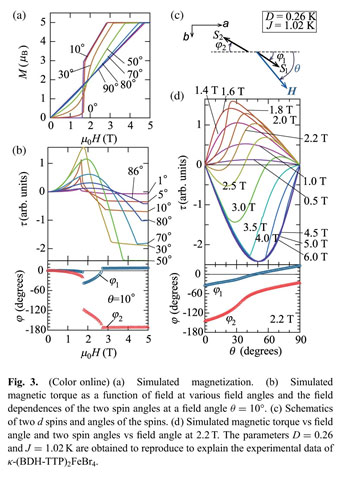
Systematic measurements of the magnetic torque of organic 3–d conductors κ-(BDH-TTP)2FeX4 (X = Br, Cl) have been performed to investigate the magnetic properties. The Fe 3d spins of both salts show antiferromagnetic (AF) orders at low temperatures. A simple two-sublattice model is found to well reproduce the essential features of the torque data in the AF states. The exchange interaction and anisotropic parameter of the ligand field obtained by the simulations are consistent with previous experimental results.
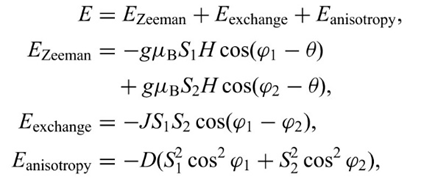
K. Sugii et al., J. Phys. Soc. Jpn.. 83 (2014) 023704
Fluctuating superconductivity in the strongly correlated two-dimensional organic superconductor κ-(BEDT-TTF)2Cu(NCS)2 in an in-plane magnetic field
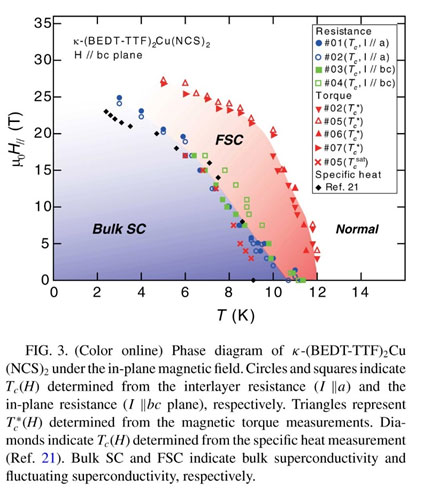
Magnetoresistance and magnetic torque measurements for the highly correlated
2D organic superconductor κ-(BEDT-TTF)2Cu(NCS)2 have been done. Under magnetic field parallel to the conducting layers,
we obtain convincing evidence of fluctuating superconductivity (FSC) in
a wide temperature and field range, where the magnetic torque shows diamagnetism
but the resistance shows no appreciable decrease. Since the vortex-Nernst
effect measurements of κ-NCS show almost no FSC above Tc under perpendicular
fields, the orbital effect of the in-plane field plays a crucial role in
the emergence of the FSC. Moreover, no appreciable FSC in NbSe2 gives an
important insight into the origin of the FSC; strong electron correlation
and/or high two dimensionality will be crucial for the FSC.
S. Tsuchiya et al., Phys. Rev. B 85 (2012) 220506(R)
Mott transition extremely sensitive to impurities in Ca3Ru2O7 revealed by HAXPES
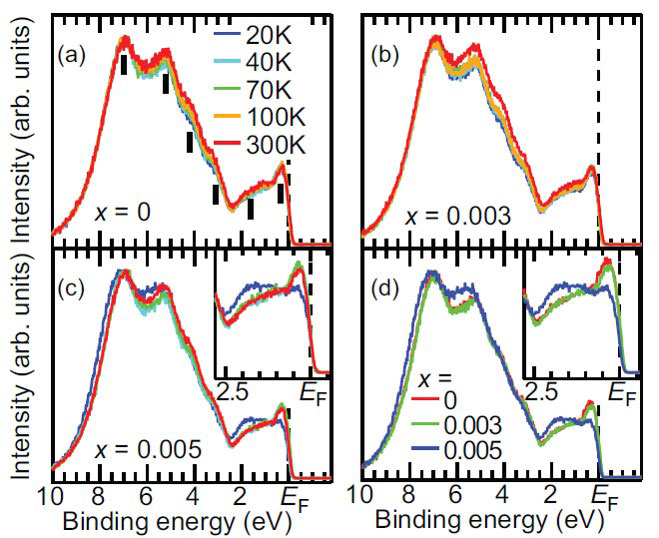
Hard x-ray photoemission studies of Ca3(Ru1−xTix )2O7 with x = 0, 0.003,
and 0.005 have been carried out to clarify the origin of the extremely
high sensitivity of the metal-insulator (M-I) transition to the amount
of Ti substitution. All the compounds show an antiferromagnetic transition
followed by a structural transition at a temperature TS, with decreasing
temperature. For x > 0, the structural transition is accompanied with
a drastic M-I transition and the intensities of the screened peaks in the
Ru 3d core-level spectra are significantly reduced below TS.
The spectral weight of the valence band is concurrently shifted toward
the higher binding energy side by an order of 2 eV, which shows that a
strong electron correlation plays an essential role for the M-I transition
at TS for x > 0. These results provide strong evidence that Mott transition
is induced by a minute amount of the Ti substitution in Ca3Ru2O7.
S. Tsuda et al., Phys. Rev. B 87, 241107(R) (2013).



